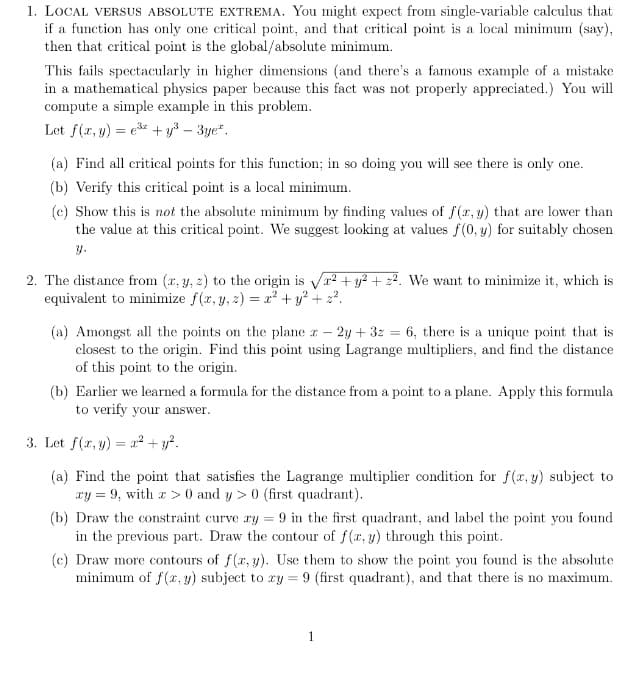1. LOCAL VERSUS ABSOLUTE EXTREMA. You might expect from single-variable calculus that if a function has only one critical point, and that critical point is a local minimum (say), then that critical point is the global/absolute minimum. This fails spectacularly in higher dimensions (and there's a famous example of a mistake in a mathematical physics paper because this fact was not properly appreciated.) You will compute a simple example in this problem. Let f(x, y) = e* + y³ – 3ye". (a) Find all critical points for this function; in so doing you will see there is only one. (b) Verify this critical point is a local minimum. (c) Show this is not the absolute minimum by finding values of f(r, y) that are lower than the value at this critical point. We suggest looking at values f(0, y) for suitably chosen y. 2. The distance from (x, y, z) to the origin is Vr? + y? + 22. We want to minimize it, which is equivalent to minimize f(x, y, z) = x² + y? + z?. (a) Amongst all the points on the plane r – 2y + 3z = 6, there is a unique point that is closest to the origin. Find this point using Lagrange multipliers, and find the distance of this point to the origin. (b) Earlier we learned a formula for the distance from a point to a plane. Apply this formula to verify your answer. 3. Let f(r, y) = a² + y?. (a) Find the point that satisfies the Lagrange multiplier condition for f(x, y) subject to xy = 9, with a> 0 and y > 0 (first quadrant). (b) Draw the constraint curve ry = 9 in the first quadrant, and label the point you found in the previous part. Draw the contour of f(r, y) through this point. (c) Draw more contours of f(r, y). Use them to show the point you found is the absolute minimum of f(x, y) subject to ry = 9 (first quadrant), and that there is no maximum. 1
Addition Rule of Probability
It simply refers to the likelihood of an event taking place whenever the occurrence of an event is uncertain. The probability of a single event can be calculated by dividing the number of successful trials of that event by the total number of trials.
Expected Value
When a large number of trials are performed for any random variable ‘X’, the predicted result is most likely the mean of all the outcomes for the random variable and it is known as expected value also known as expectation. The expected value, also known as the expectation, is denoted by: E(X).
Probability Distributions
Understanding probability is necessary to know the probability distributions. In statistics, probability is how the uncertainty of an event is measured. This event can be anything. The most common examples include tossing a coin, rolling a die, or choosing a card. Each of these events has multiple possibilities. Every such possibility is measured with the help of probability. To be more precise, the probability is used for calculating the occurrence of events that may or may not happen. Probability does not give sure results. Unless the probability of any event is 1, the different outcomes may or may not happen in real life, regardless of how less or how more their probability is.
Basic Probability
The simple definition of probability it is a chance of the occurrence of an event. It is defined in numerical form and the probability value is between 0 to 1. The probability value 0 indicates that there is no chance of that event occurring and the probability value 1 indicates that the event will occur. Sum of the probability value must be 1. The probability value is never a negative number. If it happens, then recheck the calculation.
Question 1

Trending now
This is a popular solution!
Step by step
Solved in 2 steps with 2 images






